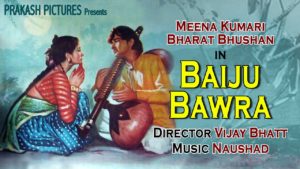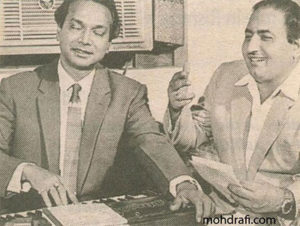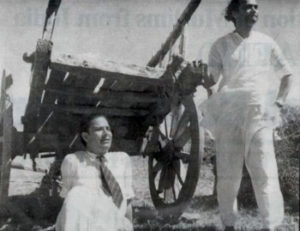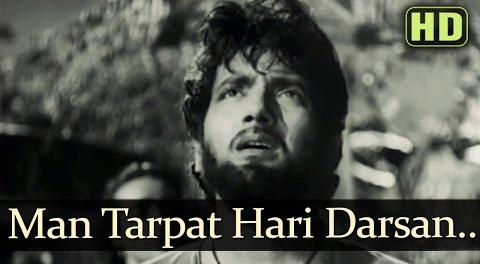Raaga Based Song of the Day: Man tadpat Hari darsan ko aaj…
Raag Malkauns, Tal Tintal
We have completed twenty-two days of Raaga Based Songs of the Day. Our first post in the series was titled ‘Raaga Based Song Of The Day #1’ and the song was a Mohammad Rafi and Lata Mangeshkar song from the 1970 Shakti Samanta movie Pagla Kahin Ka: Tum mujhe youn bhula na paoge. It is in Raag Jhinjhoti, Tal Kaherava.
Our twenty-second post was titled ‘Raaga Based Song Of The Day #22’ and the song was a Manna Dey song from the 1963 RK Rakhaan movie Meri Surat Teri Aankhen: Poochho na kaise maine rain bitayi. It is in Raag Ahir Bhairav, Tal Kaherava.
This blog has a number of posts on Raaga based songs in Hindi movies titled similarly; for example: ‘The Best Raaga Based Songs in Hindi Movies – Raaga Bhimpalasi – Part II’.
In the last twenty-two days of sharing Raaga based songs of the day, I have given you songs based on Raag Jhinjhoti, Gara, Bhimpalasi, Madhuvanti, Shivaranjani, Bihag, Pahadi, Sarang, Pilu, Bhairavi, Khammaj, Charukesi, Kalyan or Yaman, Desh, Malgunji, Kirwani, Kedar, Bageshri, Megh Malhar, Bhupali and Ahir Bhairav.
You would have noticed that I haven’t so far given you a song based on Raag Malkauns or Malkaush, the favourite raaga of my course-mate and friend Virendra Singh (Viru), his first name being an anagram of my own first name! I shall make up for that lapse today.
However, first, lets take up the value added learning of today. Today, we shall learn a little more in detail about the Jati or Jaati of a raaga:
Jati is a tonal classification of a raag based on the number of notes (swar) used in Ascending (Aaroh) and Descending (Avroh) scales. If a raag uses five notes, such a raag is on Pentatonic scale or belonging to Audhav Jati. If a raag has six notes it is on Hexatonic scale or belonging to Sadhav Jati. Finally, if it has all the seven notes, it is on Septatonic Jati or of Sampoorna (complete) Jati.
It is not difficult to imagine that the number of swar (notes) in Aaroh and Avroh need not match. Hence, following nine combinations are possible, making it a total of nine jatis of raagas:
- Sampoorna – Sampoorna Jati. Seven notes each in Aroha and Avroha. Raag Kalyan (Yaman) and Ahir Bhairav are two examples.
- Sampoorna – Sampoorna Vakra Jati. Seven notes each in Aroha and Avroha, however, in crooked manner. Raag Puria-Dhanashri and Dev-Gandhar are examples.
- Shadhav – Sampoorna (Vakra). Six notes in Aroha and seven notes in Avroha, but crooked. Raag Adana and Kausi-Kanada are examples.
- Shadhav – Shadhav (Vakra). Six notes in Aaroh and six crooked notes in Avroh. Raag Gurjari Todi and Nayaki Kanada are examples.
- Audhav – Sampoorna. Five notes in Aroha and seven notes in Avroha. Raag Sindhura is an example.
- Audhav – Shadhav (Vakra). Five notes in Aroha and six crooked notes in Avroha. Raag Sarang and Desi are examples.
- Audhav – Audhav (Vakra). Five notes in Aroha and five crooked notes in Avroha. Raag Deshkar, Gunkali, and Megh-Malhar are examples.
- Surtar – Audhav (Vakra). Four notes in Aroha and five crooked notes in Avroha. Raag Gorakh-Kalyan is an example.
- Audhav – Sampoorna (Vakra). Five notes in Aroha and all seven notes in Avroha but crooked. Raag Basant, Kamod, and Khambavati are examples.
Today’s song is in Raag Malkauns or Malkaush and Tal Tintal. Malkaush is another raag dedicated to Lord Shiva like Bhairav. Indeed, it belongs to Bhairavi Thaat. The name Malkaush is derived from the combination of Mal and Kaushik, which means he who wears a garland of snakes; ie, Shiva. It is believed that the raaga was composed by Lord Shiva’s wife Parvati to calm him down. As a matter of interest all pentatonic raagas belong to Shaivait musical school and so does Malkaush.
Now that we know a little more about the Jati of a raaga, it is of pentatonic scale both in ascending and descending scales; that is Audhav-Audhav. The five notes used are: Sa, komal Ga, shuddh Ma, komal Dha, and komal Ni. The two notes that are totally omitted are: Re (Rishab) and Pa (Pancham).
 Malkaush is a late night raaga and is calming, soothing and even intoxicating. One would use such a raaga in deep and serious meditation. One of the finest examples of Malkauns in Hindi songs is from the 1952 Vijay Bhatt movie Baiju Bawra that starred Meena Kumari as Gauri and Bharat Bhushan in the title role. The movie got Meena Kumari a Filmfare Award for Best Actress and Naushad Ali his only Filmfare Award for composing the song Tu Ganga ki mauj.
Malkaush is a late night raaga and is calming, soothing and even intoxicating. One would use such a raaga in deep and serious meditation. One of the finest examples of Malkauns in Hindi songs is from the 1952 Vijay Bhatt movie Baiju Bawra that starred Meena Kumari as Gauri and Bharat Bhushan in the title role. The movie got Meena Kumari a Filmfare Award for Best Actress and Naushad Ali his only Filmfare Award for composing the song Tu Ganga ki mauj.

Naushad Ali was one of the greatest music directors in Hindi films. He is one of the three music directors (the other two being Pankaj Mullick and RC Boral) who have been given the highest award in cinema: the Dadasaheb Phalke Award. He has been credited with having introduced Raaga based songs in Hindi movies. Indeed, in the movie Baiju Bawra, each of the 13 songs have been based on some raaga or the other.

As was often the case, the greatest songs of Naushad were penned by my favourite lyricist: Shakeel Badayuni. Also, as was often the case, their songs were sung by the best singer that we ever had: Mohammad Rafi (Please also read: ‘The Best Of Old Hindi Songs – Rafi, Shakeel, Naushad And Dilip Kumar Together’).
This is also one of the best bhajans in Hindi movies ever made and fits well with the description of Raag Malkaush that I have given: serious, meditative, soothing and calming.
Please enjoy: Man tadpat Hari darsan ko aaj….
Man ta.Dapat hari darasan ko aaj
more tum bin biga.De sakal kaaj
aa, vinatii karat, huu.N, rakhiyo laaj, man ta.Dapat…
Tumhare dvaar kaa mai.n huu.N jogii
hamarii or nazar kab hogii
sun more vyaakul man kii baat, ta.Dapat harii darasan…
Bin guruu GYaan kahaa.N se paauu.N
diijo daan harii gun gaauu.N
sab gunii jan pe tumhaaraa raaj, ta.Dapat harii…
Muralii Manohar aas na to.Do
dukh bha.njan more saath na chho.Do
mohe darasan bhikshaa de do aaj de do aaj, …
We have intended to learn about Raaga based music whilst we entertain ourselves with Raaga based songs. So, lets, once again, take stock of our collective learning so far:
- On the first day we learnt about the Raaga system devised by Pandit Vishnu Narayan Bhatkhande, which is the prevalent system in Hindustani Classical Music and based on ten Thaats.
- On the second day we learnt about Tal or Taal.
- On the third day we learnt about characteristics of Raagas that included Swar, Jati, Thaat, Arohana and Avarohana, Vadi, Samvadi and Pakad.
- On the fourth day, we learnt about Sargam.
- On the fifth day, we learnt about notations used in Indian classical music or simply Swar Lipi.
- On the sixth day, we learnt about the Ras (sentiments) that Raagas evoke.
- On the seventh day, we learnt about various types of Swar: Shuddha, Achal, Vikrut, Komal and Teevra.
- On the eighth day, we learnt the parts of a composition in Indian Classical Music.
- On the ninth day, we learnt the names of some of the popular instruments used in Indian Classical Music.
- On the tenth day, we learnt about the sources of names of Raagas.
- On the eleventh day, we learnt about why Bhairavi is the first raag to be taught to beginners and also why it is the last in a performance.
- On the twelfth day, we learnt about Khammaj Thaat.
- On the thirteenth day, we learnt about Tal Punjabi Theka or Sitarkhani.
- On the fourteenth day, we learnt about Alap.
- On the fifteenth day, we learnt about List of Raagas (Raagmala) in my favourite book: Sri Guru Granth Sahib.
- On the sixteenth day, we learnt about tips for raaga identification.
- On the seventeenth day, we learnt the basics of Gharana system.
- On the eighteenth day, we learnt about Filmi Sangeet.
- On the nineteenth day, we learnt about the commonest Tal in Raagas: Tintal.
- On the twentieth day, we learnt about the Kafi Thaat.
- On the twenty-first day, we learnt a little more in detail about the classification of Raagas.
- On the twenty-second day, we learnt the essential differences between Bhairavi and Bhairav.
- And today, on the twenty-third day, we learnt a little more in detail about the Jati or Jaati of a raaga.
There is much more still to be learnt and enjoyed.
Please stay tuned!

Fantastic series of posts. These posts are both entertaining as well as educational. Hats off for your passion and your efforts to educate others. I read a number of them and found them to be of the highest standard. Also, good to know various songs that your hear often and learn about the raagas on which they are based. Looking forward to your posts.
Thank you so much my namesake. Will continue the series for quite some time and I hope you won’t be disappointed.